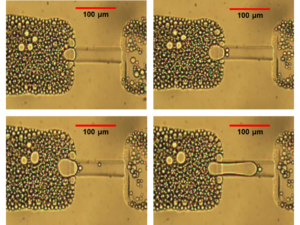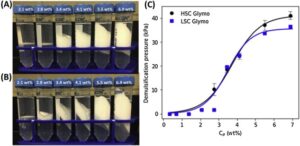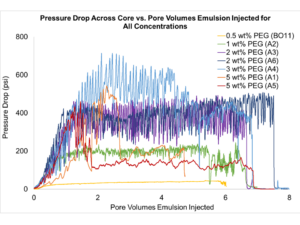Our work on nanoparticle-stabilized foams and emulsions broadly focuses on controlling the rheology of foams and emulsions through surface properties of the metal oxide nanoparticles (silica, alumina) used to stabilize them. Currently we have 2 projects in this research area.
Emulsion strength and flow through porous media
We have been investigating the flow of oil-in-water emulsions stabilized with silica nanoparticles coated with epoxy, (3-Glycidyloxypropyl)trimethoxysilane (glymo) and polyethylene glycol (PEG). Micromodel experiments of emulsion flow through a channel with a restriction have shown that partially hydrophobic nanoparticles produce stronger emulsions that resist coalescence while flowing through a restriction, but require higher pressures to flow (Fig. 1). This information can be used to design conformance control fluids.

Figure 1. Weak emulsion stabilized with hydrophilically-coated nanoparticles displaying coalescence while flowing through a restriction.
Our current work involves investigating the relationship between emulsion strength and nanoparticle concentration and water salinity using glymo- and PEG-coated silica nanoparticles. Centrifuge experiments with emulsions stabilized with glymo-coated nanoparticles have shown that higher nanoparticle concentrations produce stronger emulsions up to about 5% nanoparticles by weight in the brine phase. Above this concentration, the increase in strength is much smaller (Fig. 2). We have observed a similar phenomenon with flow of emulsions stabilized with PEG-coated silica nanoparticles through Boise Sandstone cores, with larger pressures required to flow emulsions up to about 3 wt% nanoparticles in the brine phase, but weaker emulsions with higher nanoparticle concentration. We are investigating these phenomena in terms of attachment energies and nanoparticle coverage on the droplet surfaces.

Figure 2. (a) Low- and (b) high-coverage (LSC and HSC) glymo-stabilized emulsions after centrifugation for 15 min at 5000 x g. (c) Calculated demulsification pressures for LSC (blue squares) and HSC (black circles) glymo-stabilized emulsions. Lines are to guide the eye. Figure from Griffith and Daigle (2020).

Figure 3. Pressure drop across a Boise Sandstone core versus pore volumes injected for flow of oil-in-water emulsions stabilized with PEG-coated silica nanoparticles at various concentrations. Figure from Hatchell et al. (2019).
CO2 foams stabilized only with surface-modified silica nanoparticles for enhanced oil recovery
Collaborative project with Universidad Juárez Autónoma de Tabasco funded by ConTex

Foams made of carbon dioxide in water have been used for many years to extract remaining oil from fields that already have extensive production histories. These foams are inherently unstable and require the addition of chemicals to the water phase to improve their stability in subsurface formations during flow. The chemicals used for this purpose have drawbacks, including environmental and health risk, particularly in offshore applications, and reduced efficacy at high temperature and/or in very salty brines that are often encountered in oil reservoirs. Recent work has shown that nanoparticles that are coated with certain organic compounds can alleviate some of these drawbacks by reducing or eliminating the need for other chemicals and providing superior performance in high temperature and high-salinity applications. However, the mechanisms underlying these observations are still poorly understood, and relatively little is known about the relationship between the nanoparticle surface coatings and the properties of the resulting foams, particularly when flowing through rocks and in the case when nanoparticles are used by themselves to stabilize the foam. Here, we propose a collaborative project to investigate the fundamental properties of CO2 in-water foams stabilized only with nanoparticles. The project will involve nanoparticle synthesis and characterization; surface coating and foamability studies; observations of foam flow in micromodels; and observations of foam flow in rock cores at elevated temperatures.
References
Griffith, C., Daigle, H., 2020. A comparison of the static and dynamic stability of Pickering emulsions. Colloids and Surfaces A, 586, 124256, https://doi.org/10.1016/j.colsurfa.2019.124256
Hatchell, D., Griffith, C., Daigle, H., 2019. Examining the dynamic stability of Pickering emulsions during flow through porous media. Abstract H13R-2007 presented at the American Geophysical Union Fall Meeting, San Francisco, CA, 9 December.
